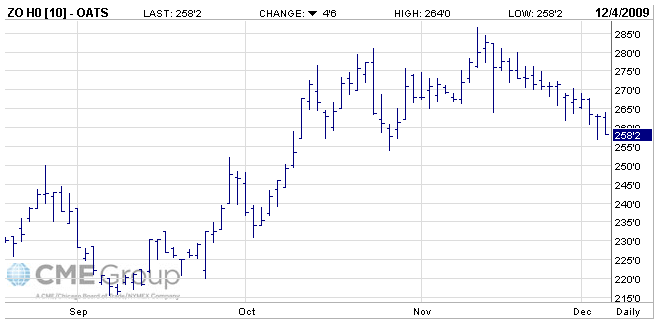Yesterday’s Statistics Canada production report contained a lot of startling numbers, with lots more spring wheat and canola for the market to digest and lots less oats. But the market shrugged it off, the charts seem to suggest. That’s a good thing, because the big numbers for wheat and canola could undermine the strength of the prairies’ two biggest crops and the main moneymakers for farmers.
I was in a session at the Prairie Oat Growers Convention in Brandon yesterday when my Blackberry buzzed with the Stats Can numbers and they didn’t seem very friendly for prices. And they were noticed south of the border, where quickly the bigger wheat and canola crops became the top item in the U.S. ag news services I check. Uh-oh, I thought, this could get a little ugly.
But the markets didn’t show much direct impact and stayed stuck to bigger, longer term factors and we didn’t see a wholesale selloff of spring wheat and canola prices. Check out this Winnipeg canola futures chart and this Minneapolis spring wheat chart:


I asked Randy Strychar of OatInsight.com, who was giving the market outlook at the POGA meeting, what he thought of the smaller oats estimate. He smiled and noted that’s what he’d been expecting. And he thinks that lowering will continue, because some of the Saskatchewan farmers at the meeting had been telling him their oats had been so badly beaten up in the swath that they’d just baled them for feeding, rather than trying to harvest them for the milling market. Randy thought that the survey likely was done when there was still swathed oats lying in the field, and they probably assumed much of that would be combined. So if they weren’t, then oats stocks will probably fall in future reports. That’s bullish for prices, and part of the trend that he expected to see, but the Chicago oats futures market didn’t do much with the bullish news yesterday. Like with wheat and canola, it didn’t seem to look at the report:

It’s been a week of surprising news. This morning both Canada and the U.S. gave the world’s equity markets a nice boot upwards, finding lots of jobs being created in Canada and finding fewer jobs being lost in the U.S., an American situation I heard Bloomberg radio commentators describing as a “less worse” situation than expected. That led to a general leaping up of equity markets this morning at the open, but Toronto soon fell off.
The big, stinking surprise we’re all waiting for in the ag world is, of course, Stephen Harper getting China to drop its ban on Canadian canola. Wouldn’t that be nice news to take into the weekend? A lot of folks here in Winnipeg are waiting for that news to come. It’s probably not safe to hold your breath about, though. China’s already thrown Canada a bone this week, by officially allowing in Canadian pork, and they may have considered that a sufficient opening gift to give Harper, a foreign leader they don’t much like because of his snubbing of the Beijing Olympics and mouthing about Chinese human rights abuses.
Read Also

Crop profitability looks grim in new outlook
With grain prices depressed, returns per acre are looking dismal on all the major crops with some significantly worse than others.
Perhaps ending the canola ban will be a good-bye present. It’d be nice to get surprised again.















